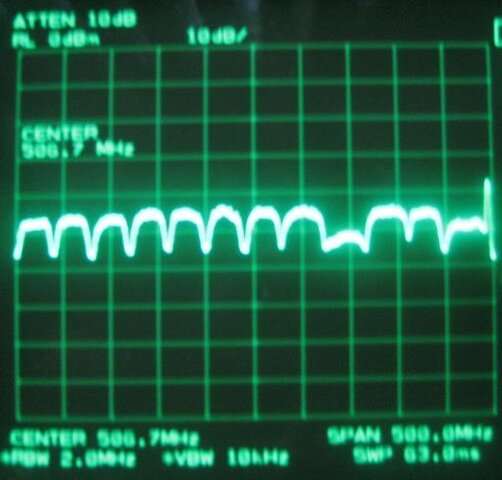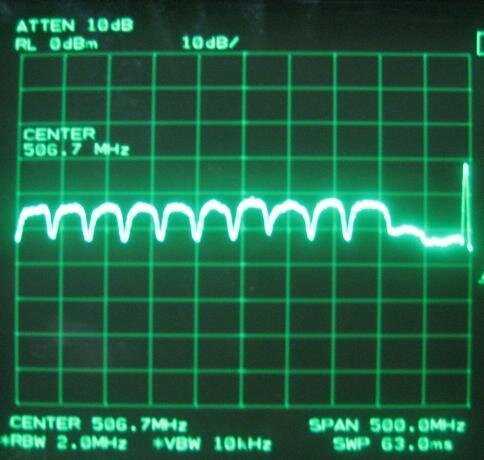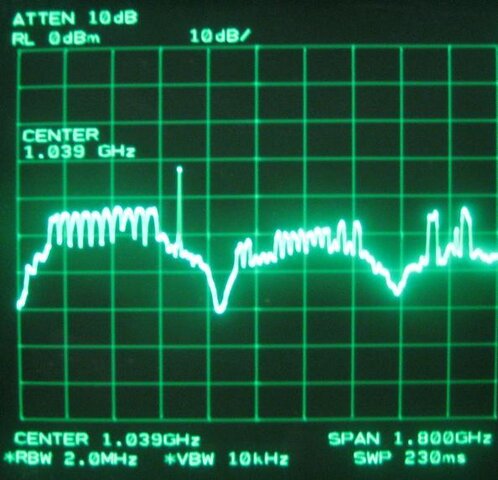Bitrates from 103b TP6
- Thread starter TheSpecialist
- Start date
- Latest activity Latest activity:
- Replies 33
- Views 8K
You are using an out of date browser. It may not display this or other websites correctly.
You should upgrade or use an alternative browser.
You should upgrade or use an alternative browser.
- Status
- Please reply by conversation.
DVB-S2 can be used with either QPSK or 8PSK. DirecTV is using it with QPSK, which is significantly less efficient than the 8PSK modulation used by Dish Network.They are using DVB-S2 which is similar to the 8PSK type of gains. Actually, you'll see DVB-S2 referred to as 8PSK overseas.
It looks like DirecTV is getting 38Mbit per TP after FEC, close to E*'s bandwidth of 41Mbit per 8PSK TP.
DVB-S2 can be used with either QPSK or 8PSK. DirecTV is using it with QPSK, which is significantly less efficient than the 8PSK modulation used by Dish Network.
7% is significant?
DVB-S2 can be used with either QPSK or 8PSK. DirecTV is using it with QPSK, which is significantly less efficient than the 8PSK modulation used by Dish Network.
It's not just a matter of efficiency, it's also a matter of the robustness and reliability of the transmission link.
QPSK is a very conservative modulation scheme that is more reliable under marginal conditions. 8PSK requires more optimal conditions and/or a larger dish. (Hence the Dish 1000.2 or separate dishes for 129.)
7% is significant?
The efficiency gain with 8PSK is far more than 7%. The efficiency gain is such that Dish Network has more usable bandwidth with 27MHz transponders than DirecTV does with 40MHz transponders.
If DirecTV were using 8PSK at 2/3 FEC, they would have 58+Mbps usable.
It's not just a matter of efficiency, it's also a matter of the robustness and reliability of the transmission link.
QPSK is a very conservative modulation scheme that is more reliable under marginal conditions. 8PSK requires more optimal conditions and/or a larger dish. (Hence the Dish 1000.2 or separate dishes for 129.)
Of course. Presumably, DirecTV did testing and found QPSK was necessary to provide their coverage area with a robust signal (i.e. sufficient resistance to inclement weather). Still, DirecTV was able to use 8PSK @ 3/4 FEC with the spots on Spaceway, so I think many assumed they would use 8PSK with 2/3 or 3/5 FEC on D10.
The efficiency gain with 8PSK is far more than 7%. The efficiency gain is such that Dish Network has more usable bandwidth with 27MHz transponders than DirecTV does with 40MHz transponders.
If DirecTV were using 8PSK at 2/3 FEC, they would have 58+Mbps usable.
I was simply using what you said but put it to math... 41mbps vs. 38mbps. Around 7%.
I have seen some information about the transponder configurations floating around other sites that is based off of assumptions prior to the satellite being operational. At this time, this is my best guess at 103b's config:
Vertical: 10 TPs probably QPSK 2/3 yielding ~38Mbit.
Horizontal: 11 TPs probably QPSK 2/3 also.
See attached spectrums for reference. Note the span is 500MHz on the first two. The last is the entire spectrum from the switch, which places the 103b Ka freqs in the lower portion, the middle is DBS, and the upper is the spotbeam Ka freqs. I appologize for the blurry pic, my camera was running low on battery.
None of this is set in stone. I am guessing at the modulation based off the bitrates seen in the transport stream. However I can only analyze the transponders that show up in the signal strength menu, the others carry unknown payloads at this time.
Vertical: 10 TPs probably QPSK 2/3 yielding ~38Mbit.
Horizontal: 11 TPs probably QPSK 2/3 also.
See attached spectrums for reference. Note the span is 500MHz on the first two. The last is the entire spectrum from the switch, which places the 103b Ka freqs in the lower portion, the middle is DBS, and the upper is the spotbeam Ka freqs. I appologize for the blurry pic, my camera was running low on battery.
None of this is set in stone. I am guessing at the modulation based off the bitrates seen in the transport stream. However I can only analyze the transponders that show up in the signal strength menu, the others carry unknown payloads at this time.
Attachments
I have seen some information about the transponder configurations floating around other sites that is based off of assumptions prior to the satellite being operational. At this time, this is my best guess at 103b's config:
Vertical: 10 TPs probably QPSK 2/3 yielding ~38Mbit.
Horizontal: 11 TPs probably QPSK 2/3 also.
See attached spectrums for reference. Note the span is 500MHz on the first two. The last is the entire spectrum from the switch, which places the 103b Ka freqs in the lower portion, the middle is DBS, and the upper is the spotbeam Ka freqs. I appologize for the blurry pic, my camera was running low on battery.
None of this is set in stone. I am guessing at the modulation based off the bitrates seen in the transport stream. However I can only analyze thetransponders that show up in the signal strength menu, the others carry unknown payloads at this time.
The DIRECTV 10 satellite is capable of supporting 14 Ka-band transponders (7 LHCP and 7 RHCP) providing coverage via a national beam and 10 Ka-band transponders (5 LHCP and 5 RHCP) providing coverage via 49 spot beams. 40MHz channel spacing and each channel 36MHz wide.
Lyngsat shows D10 operating at 20,000K Symbol Rate 5/6 FEC ~ but with a 36MHz useble RF bandwdth I would expect QPSK 2/3 - 5/6 FEC payload data rate's of 44 - 55Mbps. (To me) It looks like D10 could handel 8 HD channels per transponder, am I wrong?
http://svartifoss2.fcc.gov/servlet/ib.page.FetchAttachment?attachment_key=-73814
They are changed freq map with 24 tpns - read that thread from URL above (post#184).
Lyngsat in the case show speculative data, as no real evidence exist of using the posted parameters.
Lyngsat in the case show speculative data, as no real evidence exist of using the posted parameters.
They are changed freq map with 24 tpns - read that thread from URL above (post#184).
Lyngsat in the case show speculative data, as no real evidence exist of using the posted parameters.
You got a spectrum too, kewl. 7 LHCP and 7 RHCP (conus) and 5 LHCP and 5 RHCP (49 spot beams) is 24 transponders. What's interesting about TheSpecialist sweep's is that it looks like d10 is only usng 75% of the 36Mhz TP bandwidth so his estimate QPSK 2/3 yielding ~ 38Mbit is probably right on.
Attachments
Approx values from my spec-a:
The 3dB rolloff of TP 1-14,17,22 is 28MHz
The 6dB rolloff of TP 1-14,17,22 is 32MHz.
The 3dB rolloff of TP 15,16,19,20 is 34MHz.
The 6dB rolloff of TP 15,16,19,20 is 40MHz.
I get low signal on 24, but appears to be a wide TP.
I get no signal on 18,21,23.
Do we know where the spots are pointed? Can they cover entire CONUS? Can be be reconfigured to CONUS? CNBCHD appears on TP 22. Either it is a CONUS beam or they are transmitting CNBC on all spots assigned to TP 22.
14 x 5 channels = 70 channels.
The 3dB rolloff of TP 1-14,17,22 is 28MHz
The 6dB rolloff of TP 1-14,17,22 is 32MHz.
The 3dB rolloff of TP 15,16,19,20 is 34MHz.
The 6dB rolloff of TP 15,16,19,20 is 40MHz.
I get low signal on 24, but appears to be a wide TP.
I get no signal on 18,21,23.
Do we know where the spots are pointed? Can they cover entire CONUS? Can be be reconfigured to CONUS? CNBCHD appears on TP 22. Either it is a CONUS beam or they are transmitting CNBC on all spots assigned to TP 22.
14 x 5 channels = 70 channels.
Thank you for the good reading material!
Approx values from my spec-a:
The 3dB rolloff of TP 1-14,17,22 is 28MHz
The 6dB rolloff of TP 1-14,17,22 is 32MHz.
The 3dB rolloff of TP 15,16,19,20 is 34MHz.
The 6dB rolloff of TP 15,16,19,20 is 40MHz.
I get low signal on 24, but appears to be a wide TP.
I get no signal on 18,21,23.
Do we know where the spots are pointed? Can they cover entire CONUS? Can be be reconfigured to CONUS? CNBCHD appears on TP 22. Either it is a CONUS beam or they are transmitting CNBC on all spots assigned to TP 22.
14 x 5 channels = 70 channels.
I think TP22 might be driving spot beams configured to cover the U.S. The thing that supports that is a number of reports earlier in the week that people in Southern California reported losing CNBCHD and getting zero on TP22 for periods of time, and no-one else reported the same problem.
- Status
- Please reply by conversation.
Similar threads
-
- Sticky
- Replies
- 0
- Views
- 351
- Replies
- 12
- Views
- 3K
- Replies
- 13
- Views
- 2K
- Replies
- 3
- Views
- 1K





